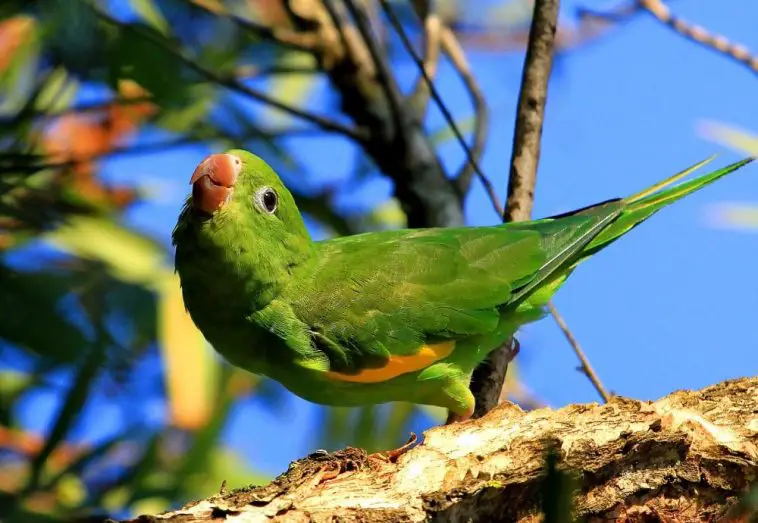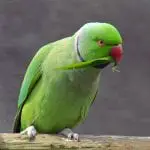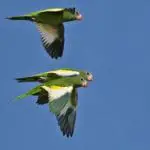Scientific Facts
| Crimson Name | Yellow Chevroned Parakeet |
| Scientific Name | Brotogeris chiriri |
| Life Span | Not recorded |
| Size | 20 to 25 cm |
| Habitat | Rainforests |
| Country of Origin | South America |
Physical Description
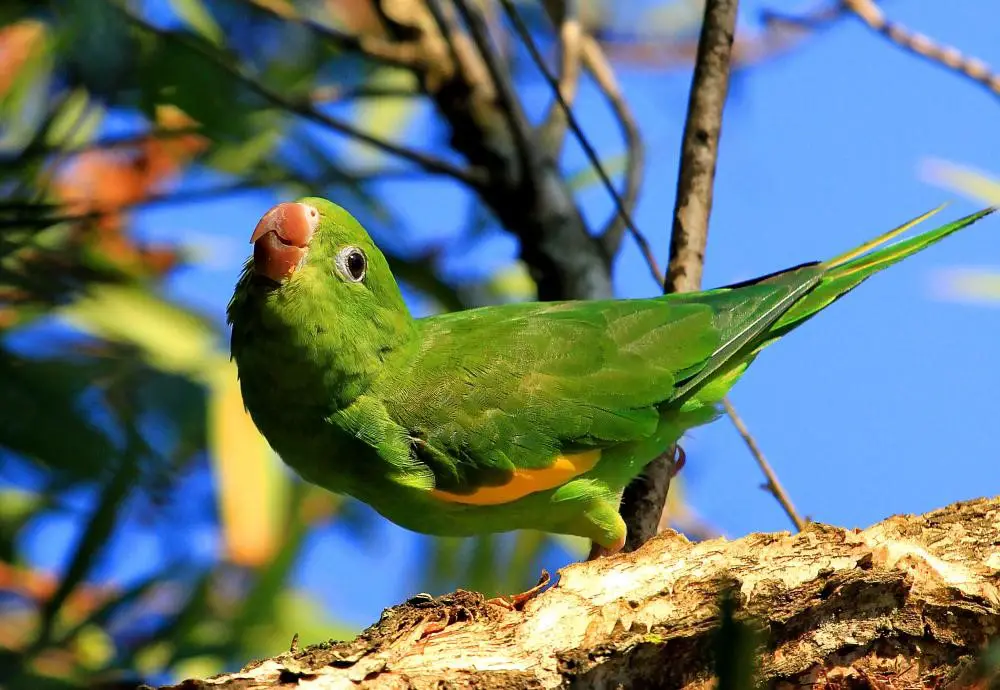
The yellow-chevroned parakeet is a lovely bird that is native to the tropical rainforests of South America. It is found in the south of the Amazon River basin, starting from central Brazil to the southern part of Bolivia, northern Argentina, and Paraguay.
Meanwhile, some caged yellow-chevroned parakeet specimens were released in other areas of the continent and have established in many areas in San Francisco, Los Angeles, Miami, California, and also in Miami, Florida.
It’s closely-related cousin; the white-winged parakeet looks very similar to the yellow-chevroned parakeet with only a few differences. And aside from the mentioned areas, this parakeet has also established itself in areas in Rio de Janeiro. According to experts, both the North American and South American populations of the yellow-chevroned parakeet continues to do well.
The parakeet is around 8 to 9 inches long and weighs around 2.5 ounces. These are slightly larger than the greycheek and the lovebird. You won’t be able to determine if a yellow-chevroned parrot is male or female because these are identical.
The bird’s plumage is bright green while the underpants are paler green with an underlying yellow-green layer. The wings have a darker green color and have a trailing yellow edge along with the folded wings, which are also visible when the bird is in flight.
The yellow-chevroned parakeet has a hook-shaped beak with an orange-brown color. The legs and the feet are greyish pink while their eyes have creamy-white rings and dark brown irises.
The juvenile birds look exactly like their parents but have shorter tails, and their bills are dark brown.
Yellow Chevroned Parakeet status
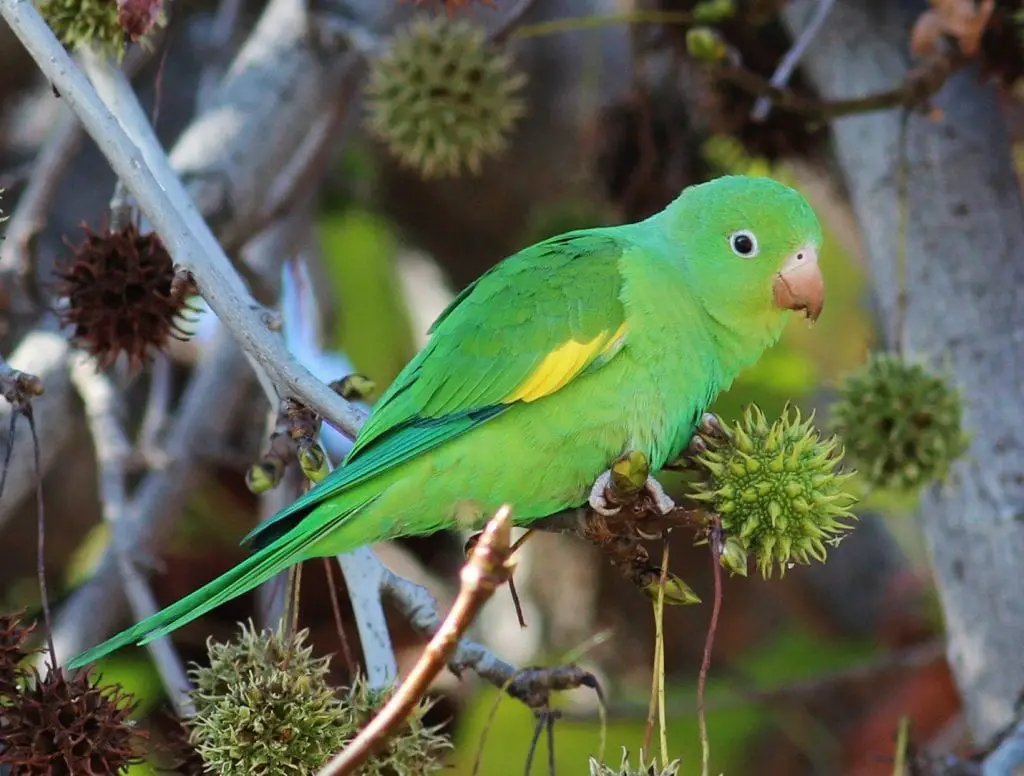
According to the IUCN conservation status list, the yellow-chevroned parakeet is doing well, and it’s of least concern. But animal support groups say that if the destruction of the rainforests and commercialization of the natural habitat of the yellow-chevroned parakeet continues, its numbers will continue to decline. Therefore, we recommend buying only birds that have been bred in captivity to stop the illegal pet trade, which is another reason for the possible decline of this parrot species.
Lifespan
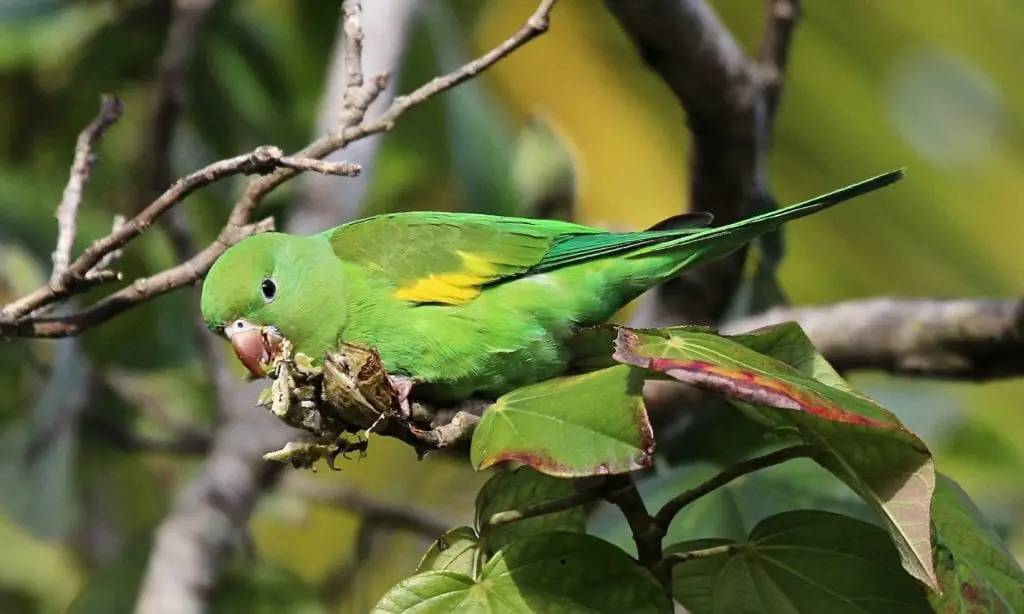
There is no recorded lifespan for the yellow-chevroned parakeet. But experts say that parrot species that are cared for in captivity are likely to live longer than their wild counterparts. Those who are lucky to care for a bird-like the yellow-chevroned parakeet say that their pets can live more than ten years.
Natural Habitat
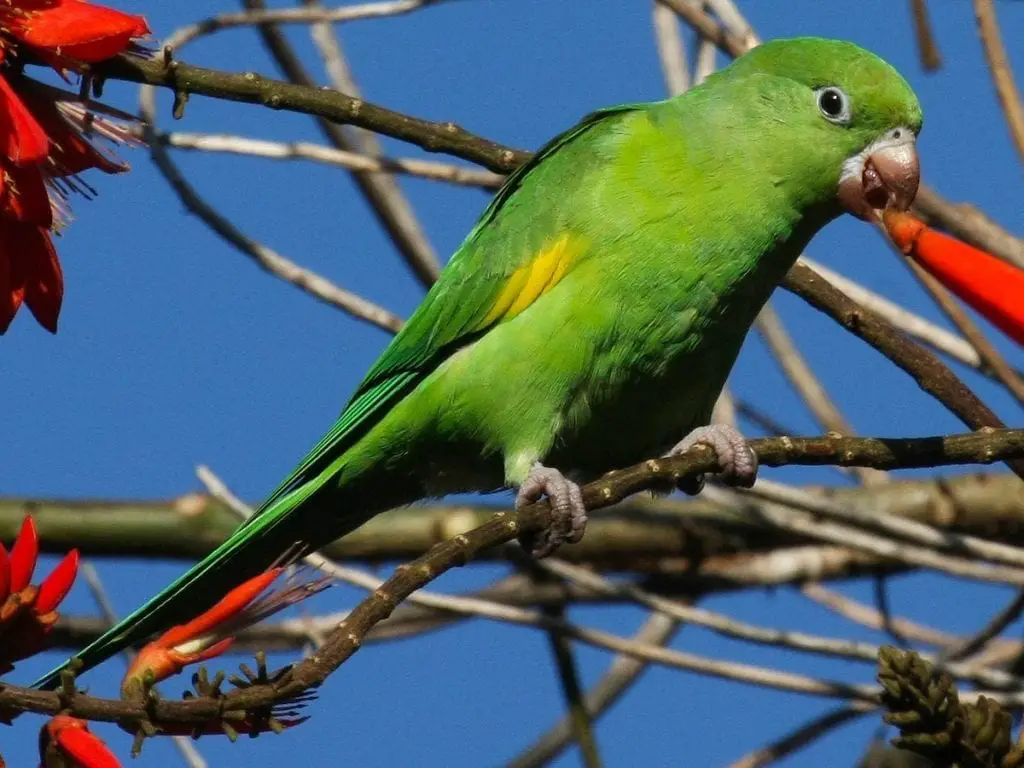
The yellow-chevroned parakeet prefers to live in rainforests where they can forage for food easily. These may also visit human populations like urban parks, gardens, and farms to look for food. These birds travel in flocks with small groups with 2 to 4 members. The largest flock of yellow-chevroned parakeets observed has 20 members.
Perception and Communication
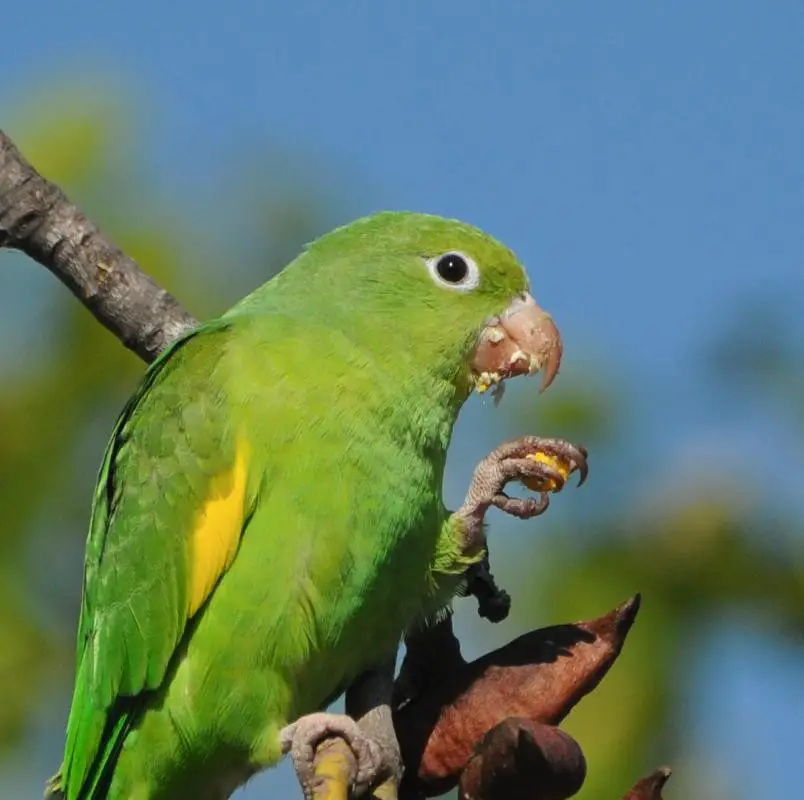
The yellow-chevroned parakeet does not have talking abilities but can mimic sounds. It can also learn how to whistle and are classified as medium-noisy parrots. Can you teach this parakeet to talk? No, it will not learn how even if you regularly interact with this pet bird. Meanwhile, some pet owners claim that they can teach their pet yellow-chevroned parakeets to talk and can mimic a few words.
Behavior
The yellow-chevroned parakeet is a social bird and can be seen in small groups of up to 4 members to a large group with up to 20 members. These are rowdy and noisy when spotted as a group, but individually, this bird will prefer to stay quiet.
This bird makes friendly and tame pets but may show jealous behavior towards other pets. So if you plan to care for this parakeet, it’s best to have it as a solo pet.
This parakeet loves to sleep snuggled together. It can sleep snuggled in a towel and hung upside down. You may also use a portable nest made of fabric to hang this bird upside down.
When it comes to breeding behaviors, yellow-chevroned parakeets are good parents in such a way that it will raise its young until these decide to leave their nest.
Development and Breeding
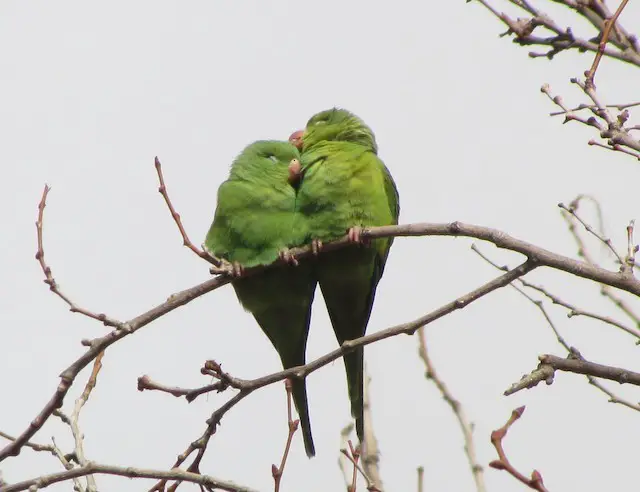
Yellow-chevroned parakeets will nest inside holes in trees, in termite nests, and inside dead palm fronds. It can take time before a male and female find a nest, but when they do, they immediately remodel the nest. The female will lay 4 to 5 eggs.
The female will continue to sit on her eggs until this hatch, usually a few days right after laying them. The eggs will hatch, but the female will continue to care for her chicks. The father will also help by looking for food and providing food for his mate and their offspring.
Food and Diet
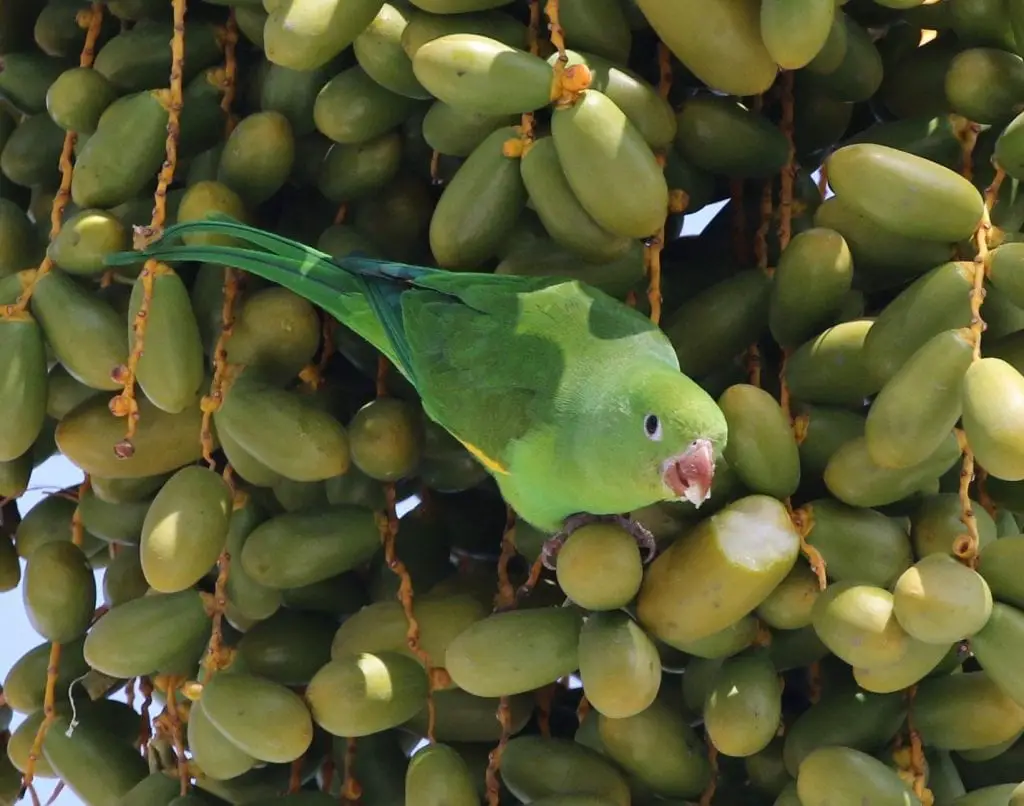
Yellow Chevroned Parakeets are herbivores with their natural diet filled with seeds, fruits, nuts, nectar, berries, and other plant-based food. Aside from plants, Yellow Chevroned Parakeets may also eat insects and insect larvae. These will eat termites, caterpillars, weevils, beetles, moths, etc.
In captivity, the Yellow Chevroned Parakeet may eat high-quality, commercially-prepared seed mixes with sunflower, oats, safflower, millets, and hemp. You may also feed your pet fresh fruits, dried berries, vegetables, pine nuts, etc.
Captive parakeets will also require nutritional supplements during the breeding season. The most important nutrient is calcium, which is needed for bone and egg health. Also, offer soft food to parent birds to feed their chicks.
You may try feeding this parakeet hemp seeds. These seeds have complete amino-acids, omega 3 and 6 fatty acids and micronutrients to boost your pet’s health. Hemp seeds also contain hi0gh amounts of protein, which is important for the good health of your pet.
Captive Environment and Housing
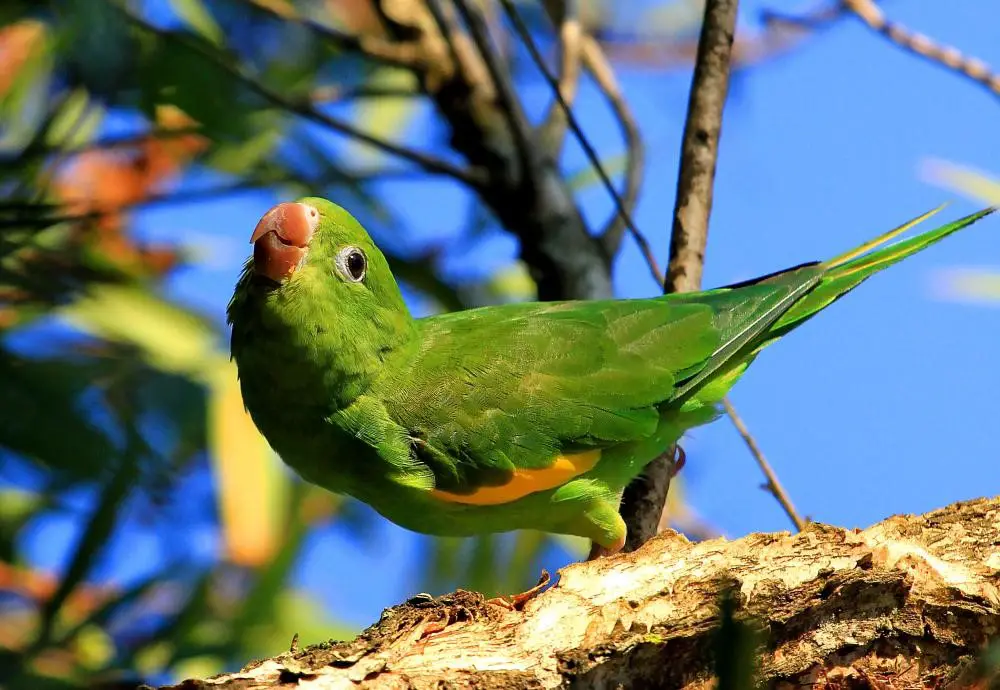
Yellow Chevroned Parakeets need a large cage. Also, you need a very large cage to keep more parakeets for the company. Use a cage made of metal with a secure door and keep this door locked and secure all times.
This bird requires strong branches where it can sit and perch. Choose natural plants where your pet can it can stay or sleep. Utilize cage furniture for your pet to play and relax. Have ropes, perching furniture blocks, birdhouses made of wood, a medium-sized bowl for bathing, mirrors, and many more.
To keep your pet hydrated, place a water basin and a container for food. The container must have a wide mouth for the bird to eat from it and use two or more food containers if you have many birds. Place the cage on top of a strong surface such as a table, or you can settle with a cage with a stand. The cage must not be under direct sunlight and must be free from moisture.
The cage should have good bedding to absorb urine and smells. Coconut husks or wood shavings may be used. You may also recycle old newspapers, paper towels or brown paper.
Clean the cage by first removing the bird from the cage and let it remain inside a separate cage. Use a powerful spray or hose to remove stuck dirt and grime. Clean food and water containers using a powerful cleaning solution.
We recommend using natural cleaning products with disinfectant properties to take care of stubborn dirt and smell. Keep live plants inside the cage, but you must care for these as well. You must remove felled or dead stems and leaves as soon as you can. Water these days and take these out from the cage to have got some sun. Make sure that these plants are healthy and do not harbor pests.
Health and Common Issues
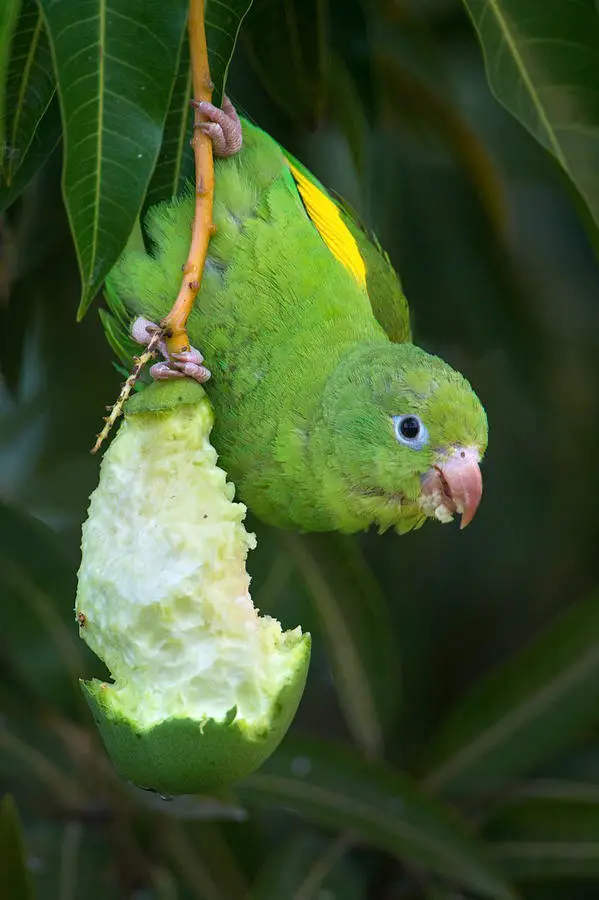
The Yellow Chevroned Parakeet is a hardy breed but is not immune to the following health issues.
Bird fever or psittacosis in birds
One of the most common but highly-infectious is bird fever. This is a disease that is common in most species of birds. Bird fever is spread through contact with the droppings of infected birds. Symptoms of bird fever are watery and green droppings, restlessness, discharge from the eyes and nose, poor appetite, and lack of energy.
Bird fever should be treated ASAP because it is contagious to humans. Pet owners should wear proper protective equipment when feeding pets or cleaning their cages and cage accessories.
Avian polyomavirus in birds
Avian polyomavirus is an infectious disease that can affect mammals and birds. This is a terrible disease that may affect very young birds. This could be passed on to other birds through droppings and by touching infected birds.
Common symptoms of avian polyomavirus are the swollen abdomen, lack of appetite, vomiting, diarrhea, and dehydration. Your pet can lose weight and may die of complications if this disease remains untreated. To prevent avian polyomavirus, have your pet vaccinated. This disease may be passed on to humans, so you must have your pet checked as soon as possible.
Malnutrition
A bird with an imbalanced diet or have a diet with insufficient nutrients could suffer from malnutrition. Any of these illnesses on our list may also contribute to malnutrition. Symptoms of malnutrition are feather stress bars and dark colors of the bird’s plumage.
You can prevent malnutrition by making sure that your bird is getting enough sunlight. This is important if your pet’s cage is indoors. You may also use artificial UV birdcage lighting.
Don’t change its diet abruptly. Captive birds may refuse to eat the new food and may starve themselves instead. If your bird refuses to eat, take it to an avian vet.
Giardia in birds
Giardia is a parasitic infection that may be passed from one infected bird to another using cysts, which are in large numbers in the bird’s droppings. The most common cause of giardia is a contaminated water supply. Symptoms may include diarrhea, weight loss, skin problems, lack of energy, and constipation. Your pet needs immediate medical help once you spot these symptoms. Giardia may be passed to humans if their water supply is the same as the contaminated water supply of birds.
Pacheco’s disease in birds
Pacheco’s disease is a viral disease coming from a type of herpes virus. The infected bird spreads this disease through contact with its droppings and nasal discharge. The herpes virus may be dormant in a bird but will be activated when the bird suffers from stress.
Some stressful conditions are moving, breeding, and the death of a mate. Symptoms of Pacheco’s disease include tremors, sinusitis, anorexia, green-colored droppings, and in extreme cases, death. You can prevent the spread of Pacheco’s disease by keeping sick birds on quarantine. This cannot be transferred to humans.
And aside from these common conditions, check your Yellow-Chevroned Parakeet for any of the following symptoms: strange appearance or stance, excessive plucking of feathers, tremors, poor balance, walking in circles, changes in behavior or attitude, changes in the bird’s droppings, breathing, eating, etc. must be consulted to a vet at once.
Preventive Care
Similar to most exotic birds, a Yellow-Chevroned Parakeet must undergo a complete physical examination every 6 months. Visit an avian veterinarian and not just an ordinary vet for the right care. For any concerns about the health of your bird, especially its diet, consult an avian vet at once.
Your pet needs an annual fecal examination to rule out the presence of yeast, parasites, and bacteria infestation. Your vet will also check for polyomavirus and routine blood testing to ensure that it is healthy and ready to socialize with other pets.
Captive birds like the Yellow-Chevroned Parakeet should have some nail and wing trimming at least once or twice a year. Consult only an avian vet who will help get these done properly and carefully.
Prevent illness by maintaining and cleaning your bird’s cage regularly. Remove droppings and wash the cage with a safe cleaner. Remove and clean the feeding and drinking dishes and all toys and cage furniture to prevent the spread of illnesses and other health conditions.
Availability – Where to Get One?
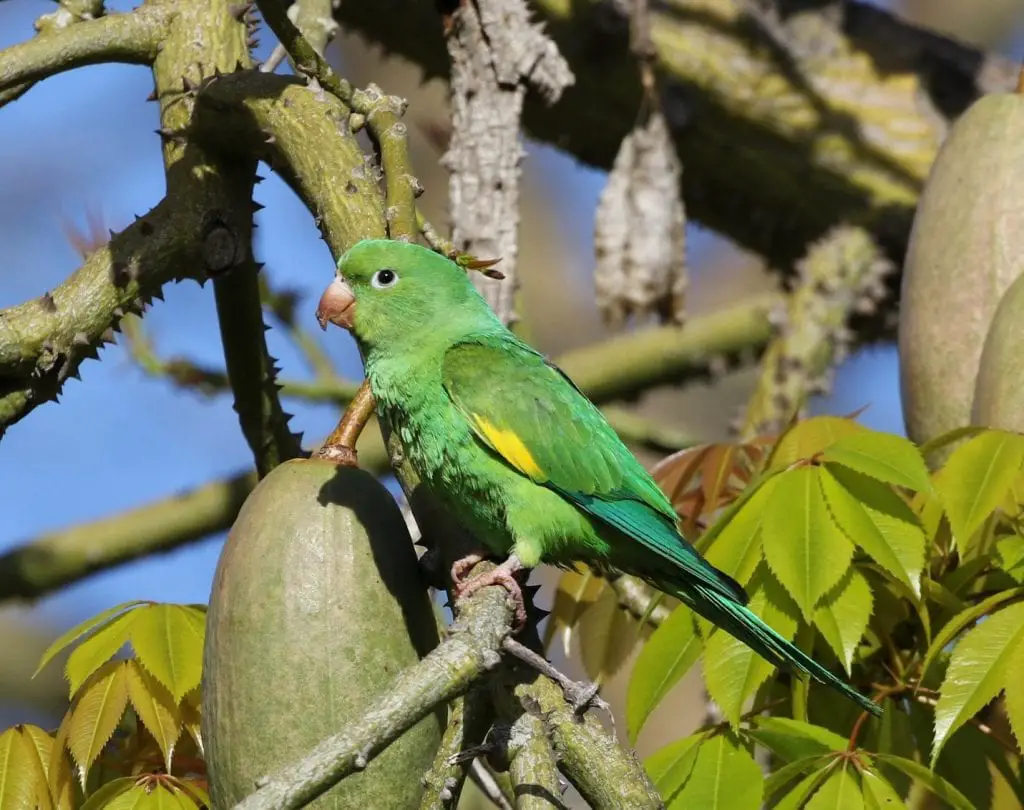
Yellow-Chevroned Parakeets are available for sale from a reputable breeder, or an avian pet store. You can buy this from an online pet shop. The price for a Yellow-Chevroned Parakeet online is from $300 to $400 depending on the age, gender, and the love plumage. A Yellow Chevroned Parakeets and other exotic birds from a breeder.
You can also check birds available for adoption from bird adoption or rescue organizations. These institutions are looking for new and loving families and homes for abandoned or rescued birds.
How to Care for a Yellow Chevroned Parakeet
Yellow Chevroned Parakeets have unique needs and also specific needs similar to other parrots. Aside from proper basic care and medical attention, you must also be willing to commit to daily cage maintenance, feeding, and interaction. Never overlook caring for your pet because doing so will help maintain your pet’s proper mental and physical condition.
Choose a large cage that’s comfortable and safe. The cage must be big enough to allow your bird to spread his wings completely. When housing two or more birds, a large cage or a custom-made enclosure is best. Add natural trees or plants to be used as natural perches and some safe bird toys.
Regular handling of this pet is necessary. This will create a close bond between you and your pet. You must hold it well and gain its trust before you can place it on your arm and shoulders. Some yellow-chevroned parakeets are not so fond of petting and holding. You must give it time to adjust to avoid stress.
When feeding your pet, offer proper bird food. You can use commercially-prepared food available in most pet shops and pet supplies shops. Feed only organic fruits and vegetables. Have a fixed feeding schedule every day, and don’t feed your pet too much to avoid being overweight and other health issues. Keep a bowl with clean water inside the cage and replace water daily.
FAQs
How do you tame a yellow-chevroned parakeet?
Tame a yellow-chevroned parakeet by constant interaction. You should talk, train, and tame your pet every day. If it won’t respond, be patient with it and don’t be too in a hurry. It will soon come out of its shell.
Will a yellow-chevroned parakeet bite you?
Yes, any bird that has not been tamed can bite you anytime. So you must be careful and do not just approach a non-tamed bird; you must win its trust first.
Can a yellow-chevroned parakeet be a pet for children?
Yes, a yellow-chevroned parakeet can be a good first-time bird pet even for a child as long as it has been tamed before you allow the child to approach it.
Where do yellow-chevroned parakeets live in the wild?
Yellow-chevroned parakeets live in the rainforests of the Amazon, where it enjoys abundant food, a lot of bird species as a company, and good clean air to breathe. To this day, there are still so many yellow-chevroned parakeets in the wild, but deforestation will one day affect the population of this bird.
Can a yellow-chevroned parakeet eat commercially-prepared food?
Yes, a captive yellow-chevroned parakeet will eat commercially-prepared food and will also eat fruits, vegetables, nuts, and other food.
Will a yellow-chevroned parakeet be aggressive towards other birds?
No, this bird is sociable, outgoing, and will love the company, so it’s not aggressive towards other birds. Because of this, you can allow your pet to live with more companies so it can socialize and form new friends.
Can you keep a yellow-chevroned parakeet with other birds inside a cage?
Yes, you can keep a yellow-chevroned parakeet with other similar breeds and other species, as well. Just make sure that you have a large cage to keep all your fine-feathered friends.
Does a yellow-chevroned parakeet love to take a bath?
Yes, most parrots love taking a bath. You can use a handheld shower to sprinkle water on the head and body. Some yellow-chevroned parakeets can take a liking to take a bath together with its owner inside the shower stall or tub.
Will, a yellow-chevroned parakeet mate for life?
No, this species will mate with a new partner every breeding season. They make nests in the highest parts of the trees and will guard their nests until their babies are ready to fledge from the nest.
Is it okay to let a yellow-chevroned parakeet free at home?
Yes, as long as you parrot-proof your home. Cover all windows and doors or any place where the bird can escape from the room. Don’t make too many noises to stress your pet, just let it fly about and relax inside your home.
Can yellow-chevroned parakeet bring diseases?
Some parrots can have diseases that may affect humans; therefore, you must have your pet vaccinated so it won’t be affected by diseases that are fatal to birds and mammals.
Are yellow-chevroned parakeet pests?
Yellow-chevroned parakeet can become pests if this bird eats garden fruits, vegetables, and nuts in gardens. But usually, yellow-chevroned parakeets will remain in high trees in rainforests and will rarely go to human areas unless it is in dire need of food or shelter.
Will yellow-chevroned parakeet eat food in your garden or orchard?
Yes, the yellow-chevroned parakeet can eat food like fruits, veggies, nuts, and berries in a garden or orchard. You can prevent this by using a scarecrow to scare these birds away.
Is it okay to incubate the eggs of a yellow-chevroned parakeet?
As long as the nest has been abandoned, meaning the parents did not return to care for the egg, then you may rescue the egg and incubate it at home. Create a nest by using old clothing and place this inside a shoebox. Place this under a strong lamp and place the egg in the middle. Given the right circumstances, this may crack open after just a few weeks.

